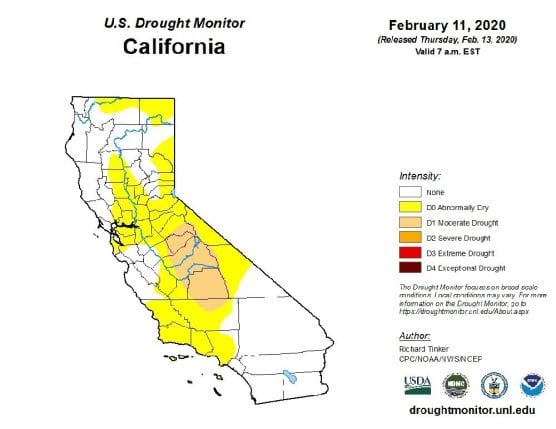California slipped into drought once again as dry skies prevailed throughout the back half of January and the first half of February.
The lack of precipitation in the Sierra Nevada and the Central Valley means 9.5% of the Golden State is listed as being in moderate drought according to the U.S. Drought Monitor’s weekly report.
The news bodes ill for the state, which experiences a Mediterranean climate characterized by precipitation-free summers and a window in winter when the region gets most of the rainfall required for residents, businesses, farms and ecosystems.
“Since mid-December, less than half of normal precipitation has fallen from central and southern Nevada westward across most of California, with less than 25% of normal observed in the southern Sierra Nevada and adjacent central valleys,” the drought monitor said on Thursday. “Central and southern sections of coastal California accumulated 3 to 8 inches less precipitation than normal during this period while deficits of 5 to 12 inches piled up in the Sierra Nevada.”
The federal agency also applied the “abnormally dry” into San Luis Obispo, Santa Barbara, Ventura and Los Angeles counties, as well as parts of Northern California.
The lack of snowpack in the Sierra Nevada figures to cause consternation among the state’s water managers, as the snowpack as it builds up during the winter and melts slowly over the spring, replenishing the state’s network of reservoirs. The state gets nearly a third of its water supply from the Sierra snowpack alone.

“After a good start in December, January saw dry conditions that added little to the Sierra snowpack,” said California Department of Water Resources Director Karla Nemeth said in late January.
At the time, the snowpack was 72% of the average.
Since, hardly a speck of snow has fallen in the mountains as the calendar has turned to February.
December, January and February are typically the wettest months of the year for California, but so-called March Miracles have bailed out the state in previous years.
The National Weather Service said Wednesday that the dry pattern in Northern California will continue for the next one to two weeks, as a high-pressure system is encamped above the region and pushing weather systems to the north.
It’s good news for the Pacific Northwest, which has enjoyed heavy rains in recent weeks, and drought-like conditions in the leeward portions of Oregon and Washington state have been alleviated.
But California is staring at a dry February with above-average temperatures eating at a snowpack that was built up in December.
“As climate change continues to impact California’s snowpack, we look to actions described in the recently released California Water Resilience Portfolio to meet the challenges brought by weather variability to California’s water supply.”
The resilience portfolio is a multiagency effort to form solutions to deal with inevitable water shortages as the prospect of longer more severe droughts in California become commonplace with rising global surface temperatures.
California is not the only state afflicted with drought: Its neighbor to the east, Nevada, has entered into a drought period as well.

The first Sierra snowpack survey of 2020 on Jan. 2 found 33.5 inches of snow near South Lake Tahoe and a snow-water equivalent of 11 inches — 97% of average for the location. (California Department of Water Resources via Twitter)
The Four Corners region, where Colorado, New Mexico, Arizona and Utah abut has also experienced prolonged dry conditions and much of the region remains in moderate to severe drought.
Meanwhile, south Texas has suffered under a stint of cloudless days and no precipitation.
“Most areas of dryness and drought across central and southern Texas received little if any precipitation, prompting areas of drought intensification and expansion,” the drought monitor said Thursday. “Severe drought now covers large portions of central and southwestern Texas.”
Much of the region near the Rio Grande has received 25% of normal precipitation over the past year, according to the report.
— By Matthew Renda
Like this:
Like Loading...
Related





 Tweet This
Tweet This Facebook
Facebook Digg This
Digg This Bookmark
Bookmark Stumble
Stumble RSS
RSS




























REAL NAMES ONLY: All posters must use their real individual or business name. This applies equally to Twitter account holders who use a nickname.
0 Comments
You can be the first one to leave a comment.